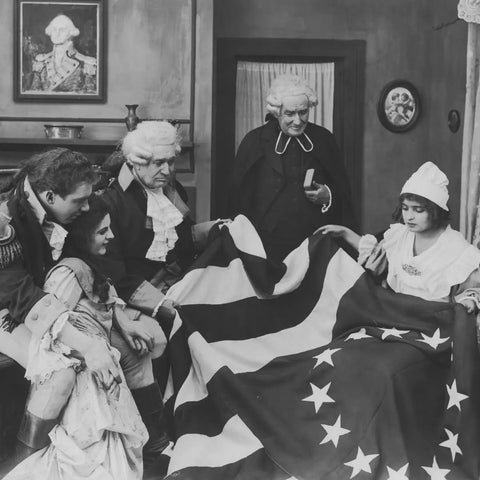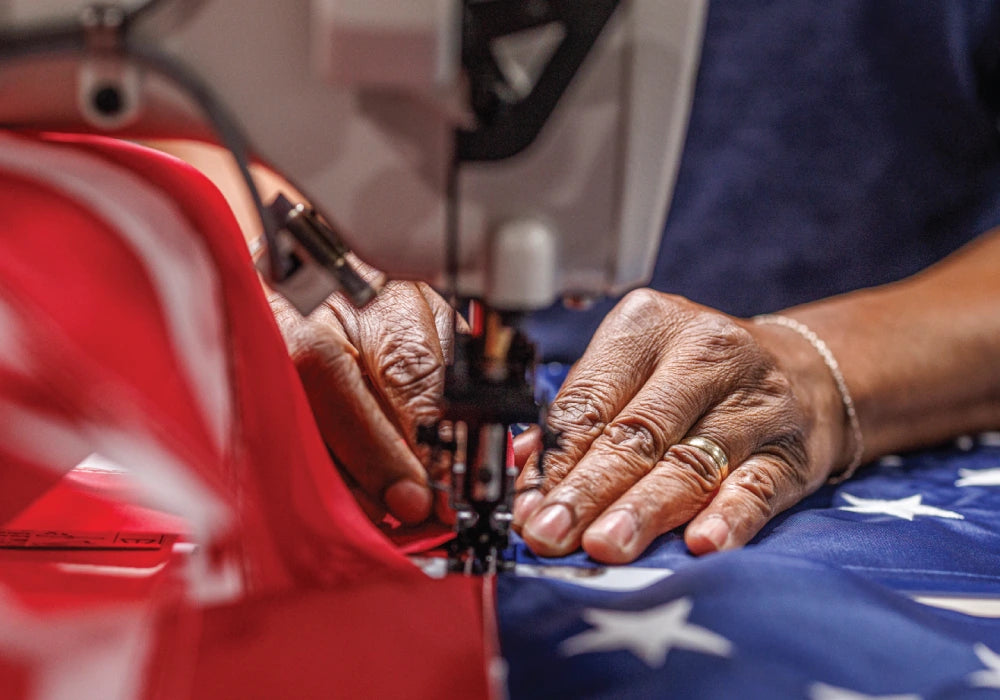Despite its popularity, the Betsy Ross narrative faces skepticism from historians who point out inconsistencies and the lack of direct evidence. Alternative theories suggest that others may have been involved in the design and creation of the original American flag or that the flag evolved organically over time through contributions from multiple individuals. This skepticism has sparked further research into the origins of the American flag, examining flags used during the Revolutionary War that may have influenced the design that Ross is said to have sewn.
The Betsy Ross Flag: Legend and Legacy
The Story of Betsy Ross and the Revolutionary War
According to popular legend, Betsy Ross crafted the first American flag at the request of George Washington during the early stages of the Revolutionary War. It's said that Ross, an upholsterer from Philadelphia, was approached because of her skills with a needle and thread. The tale recounts how she proposed changes to Washington's original sketch, notably altering the stars from six-pointed to the easier-to-produce five-pointed design. This story, deeply ingrained in American folklore, emphasizes Ross's role in shaping a symbol of national identity.

While the story of Betsy Ross and her flag is cherished, concrete historical evidence is sparse. Documentation from the period that directly names Ross as the flag-maker is limited to affidavits from her family members decades after the flag's supposed creation. These second-hand accounts have fueled both scholarly research and public interest, forming a narrative thread that connects the past to present-day American flag history. Nevertheless, these documents are vital in sustaining the legacy of Ross's contribution to American symbolism.
Cultural Impact of the Betsy Ross Narrative
The legend of the Betsy Ross flag has had a profound cultural impact, symbolizing American resilience and ingenuity. This narrative has been celebrated in schools, literature, and popular media, embedding it into the national consciousness as a pivotal moment in American history. The story also serves as an inspiration, highlighting the significant role women played during the Revolutionary War—a time when their contributions were often overlooked. Such an enduring story not only commemorates historical events but also champions the broader themes of participation and recognition in the shaping of national identity. Some ideas suggest that others may have been involved in the design and creation of the original American flag or that the flag evolved organically over time through contributions from multiple individuals. Skepticism has sparked further research into the origins of the American flag, examining flags used during the Revolutionary War that may have influenced the design that Ross is said to have sewn.
Alternative Theories About the First Flag
Contributions of Francis Hopkinson
A signer of the Declaration of Independence, Francis Hopkinson is another notable figure in the history of the American flag. Records show that Hopkinson submitted bills to the Continental Congress for designing the U.S. seal and, presumably, the flag. Unlike the anecdotal evidence surrounding Ross, there is documentation suggesting Hopkinson's direct involvement, which lends credence to the theory that he might have designed the first American flag, introducing the stars and stripes layout that is familiar today.
The Role of Revolutionary War Flags
During the Revolutionary War, various flags used by American forces served not only as practical battle standards but also as powerful symbols of the colonies' fight for independence. These flags often bore different emblems and mottos, which were tailored to the militias they represented. The diversity in these reflects a period of experimentation and evolution in symbolizing national identity, which likely influenced the final design of the original American flag.
Variations in Early American Flag Designs
The first design of the American flag underwent several iterations in its early years, reflecting the evolving political and social landscape of the newly formed nation. Each version carried specific elements that were later incorporated into the standard design, such as varying numbers of stripes and changes in the arrangement of stars.
The Flag’s Role as an Early War Symbol
The American war flag transcended its role as a mere identifier on the battlefield. It was also used in diplomacy and communication, serving as a sign of the emerging nation’s identity and resolve. The presence of the flag in early diplomatic missions and significant events helped to legitimize the new nation in the eyes of foreign powers and played a critical role in gaining international support and recognition.
American Battle Flags of the Revolutionary Era
Key Features of Early American Battle Flags
The battle flags of the Revolutionary War were not only vital for identification on the field but also served as potent symbols of the colonies’ fight for independence. Here are some key features of these flags:
- Symbolic Colors: The use of red, white, and blue in early battle flags was deeply intentional, with each color carrying symbolic significance. Red represented courage and hardiness, a nod to the bravery required to fight for freedom against overwhelming odds. White signified purity and the colonists' noble aspirations for a just society free from tyranny. Blue symbolized vigilance, perseverance, and justice, reflecting the steadfast resolve to uphold their rights and ideals. These colors were not just decorative; they conveyed the values and principles that unified the troops and reinforced their shared purpose.
- Distinctive Emblems: Many Revolutionary War flags bore unique emblems or mottos that captured the ethos of the fight for independence. The Gadsden flag featured a coiled rattlesnake and the defiant motto, "Don't Tread on Me," symbolizing the colonies' readiness to defend their liberty. Other flags included stars, stripes, or regional symbols that held local significance, creating a visual representation of the diverse forces united against British rule. These emblems served as rallying points on the battlefield, inspiring soldiers and reminding them of the ideals they were fighting to uphold.
- Variety in Design: Unlike modern standardized flags, Revolutionary War battle flags varied widely in design, reflecting the diverse backgrounds of the colonial troops. Each regiment or militia often created its flag, incorporating elements of local culture, symbols of resistance, or religious motifs.
- Use as a Communication Tool: Beyond their symbolic value, battle flags played a practical role in conveying commands and boosting morale during engagements. Commanders used flags to signal tactical movements, such as advancing, retreating, or regrouping, making them vital tools in an era without modern communication technology. Flags were also prominently displayed to inspire troops and intimidate enemies, serving as visual reminders of the colonies' resolve and unity. The sight of a flag flying amidst the smoke and chaos of battle often provided a much-needed morale boost, reinforcing the determination to persevere.
As enduring symbols of resistance and unity, these flags continue to represent the courage and determination that defined the fight for American independence. Reflecting on their significance allows us to appreciate their role not only in military history but also in shaping the identity of a nation.

Purchasing High-Quality American Flags Today
Large and Premium American Flags
When selecting a large American flag for display, the emphasis should be on quality and craftsmanship. A high-quality American flag is typically made from durable materials that are suited for the harsh elements outdoor flags face. The choice between these materials often depends on the specific climate and the flag’s intended use. Additionally, premium flags usually feature embroidered stars and sewn stripes, which not only enhance the flag’s aesthetic appeal but also its longevity.
Supporting USA Flag Manufacturers
Opting for American-made flag manufacturers supports local businesses and ensures adherence to high production standards. These manufacturers are known for their commitment to quality, using materials that meet strict specifications for color fastness and durability. By choosing flags made in the USA, buyers also contribute to domestic employment and the economy, reinforcing the patriotic essence of purchasing a national symbol that is truly American in its creation.
Recommended U.S. Flag Shops and Online Retailers
To buy American flags online, it’s important to select reputable retailers known for their quality products and customer service. Here are some recommended steps for choosing the right shop:
- Read Customer Reviews: They provide insights into the quality of the flags, shipping reliability, and overall customer experience. Look for reviews that mention durability, color retention, and whether the product met the buyer’s expectations. Pay attention to both positive and negative feedback to get a balanced view. Retailers with consistently high ratings and repeat customers often signal reliability. By prioritizing stores with excellent reviews, you reduce the risk of disappointment and ensure your purchase meets your expectations.
- Verify Product Origins: Ensuring the flag is manufactured in the United States not only supports domestic businesses but also guarantees adherence to quality standards. U.S.-made flags are crafted with durable materials and authentic designs, adhering to the specifications outlined in the Flag Code. Many reputable retailers explicitly state the origin of their products, and those that offer “Made in the USA” certifications can be trusted. Verifying origins also reflects your commitment to buying locally and promoting American craftsmanship, adding a layer of significance to your purchase.
- Compare Prices: Price comparison is essential when selecting a flag retailer. While cheaper options may be tempting, they often compromise on material quality and durability, leading to quicker wear and tear. Balance your decision by comparing prices across multiple retailers and considering factors like free shipping or bulk discounts. Investing in a slightly more expensive but high-quality flag ensures better value in the long run, as it reduces the need for frequent replacements.
- Check for Guarantees: Guarantees are a hallmark of reputable retailers, showcasing their confidence in the quality of their flags. Shops offering warranties or satisfaction guarantees provide peace of mind, allowing you to seek replacements or refunds if the product does not meet expectations. These policies often cover defects in stitching, color fading, or material durability. A guarantee reflects the retailer’s dedication to customer satisfaction and serves as an assurance of product quality. Prioritizing retailers with such policies ensures you’re protected if any issues arise.
Taking the time to evaluate retailers ensures you purchase a flag that matches your values and expectations. By reading reviews, verifying origins, comparing prices, and checking for guarantees, you make an informed decision that upholds both quality and integrity.
Ensuring Authenticity and Durability
These guidelines include precise colors, accurate dimensions, and proper material use, which are essential for the flag’s longevity and symbolic integrity. To ensure you are purchasing a durable and authentic American flag, consider the following aspects:
- Material Quality: The foundation of an authentic and durable flag lies in its material. Premium flags are typically made from heavyweight nylon or polyester, materials known for their strength and resistance to wear. Nylon flags are lightweight, quick-drying, and ideal for areas with mild weather, while polyester is heavier and better suited for regions with strong winds. These materials are often treated to resist water, mildew, and general weathering, making them perfect for outdoor display. Choosing the right material ensures your flag remains intact and vibrant despite exposure to the elements.
- Stitching and Construction: High-quality stitching is essential for a flag’s longevity, particularly for outdoor use. Look for double or quadruple stitching on the edges and seams, as this reinforcement prevents fraying and tearing over time. The stars should be embroidered to add dimension and durability, while the stripes should be sewn individually rather than printed, ensuring they withstand repeated exposure to wind and rain. Superior construction not only enhances the flag’s aesthetic but also guarantees it will hold up under demanding conditions, reflecting its value as a long-term investment.
- Grommet Quality: Grommets are a critical component of a durable flag, securing it to poles or mounts. High-quality grommets are typically made from brass or stainless steel to resist rust and corrosion. These durable fittings ensure that the flag can be securely attached without tearing the fabric, even in windy conditions. A poorly constructed grommet can weaken the flag’s structure, leading to premature damage. Verifying the strength and material of the grommets helps ensure your flag will remain securely displayed for years to come.
- UV Protection: Outdoor flags are frequently exposed to the sun, which can cause significant fading over time. Premium flags often include UV-resistant treatments, which help maintain their vibrant red, white, and blue colors even after prolonged sun exposure. This feature is particularly important for those displaying their flag year-round or in sunny climates. UV protection not only preserves the flag’s appearance but also enhances its overall lifespan, making it a worthwhile feature to seek when purchasing.
- Certification: Some flags come with a certificate of authenticity, especially those crafted by reputable manufacturers or intended for significant occasions. These certificates confirm that the flag meets stringent production standards, including proper dimensions, colors, and materials. This adds an extra layer of assurance that your flag is not only durable but also an accurate representation of the nation’s symbol.
Ensuring that the flag embodies these characteristics will not only enhance its lifespan but also ensure that it continues to be a source of pride and patriotism, reflecting the values it is meant to represent.

As we reflect on the flag's origins and its symbolic role throughout American history, it’s crucial to recognize how it has shaped the nation’s identity. Each stripe and star tells stories of sacrifice and triumph, serving as a reminder of the ideals upon which the United States was founded. Celebrating the flag goes beyond displaying it on national holidays; it involves understanding its historical context, honoring the principles it stands for, and continuing the legacy of liberty and justice for all.






